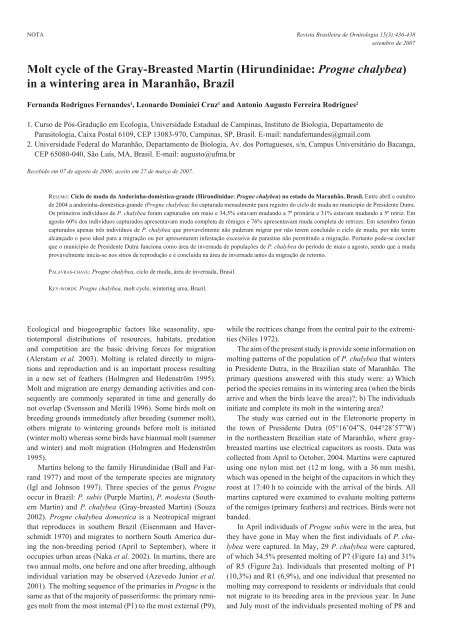Create successful ePaper yourself
Turn your PDF publications into a flip-book with our unique Google optimized e-Paper software.
436 NOTA<br />
Fernan<strong>da</strong> Rodrigues Fernandes, Leonardo Dominici Cruz and Antonio Augusto Ferreira Revista Brasileira Rodriguesde<br />
Ornitologia 15(3):436-438<br />
setembro de 2007<br />
Molt cycle of the Gray-Breasted Martin (Hirundini<strong>da</strong>e: Progne chalybea)<br />
in a wintering area in Maranhão, Brazil<br />
Fernan<strong>da</strong> Rodrigues Fernandes 1 , Leonardo Dominici Cruz 1 and Antonio Augusto Ferreira Rodrigues 2<br />
1. Curso de Pós-Gradução em Ecologia, Universi<strong>da</strong>de Estadual de Campinas, Instituto de Biologia, Departamento de<br />
Parasitologia, Caixa Postal 6109, CEP 13083-970, Campinas, SP, Brasil. E-mail: nan<strong>da</strong>fernandes@gmail.com<br />
2. Universi<strong>da</strong>de Federal do Maranhão, Departamento de Biologia, Av. dos Portugueses, s/n, Campus Universitário do Bacanga,<br />
CEP 65080-040, São Luís, MA, Brasil. E-mail: augusto@ufma.br<br />
Recebido em 07 de agosto de 2006; aceito em 27 de março de 2007.<br />
Resumo: Ciclo de mu<strong>da</strong> <strong>da</strong> Andorinha-doméstica-grande (Hirundini<strong>da</strong>e: Progne chalybea) no estado do Maranhão, Brasil. Entre abril e outubro<br />
de 2004 a andorinha-doméstica-grande (Progne chalybea) foi captura<strong>da</strong> mensalmente para registro do ciclo de mu<strong>da</strong> no município de Presidente Dutra.<br />
Os primeiros indivíduos de P. chalybea foram capturados em maio e 34,5% estavam mu<strong>da</strong>ndo a 7ª primária e 31% estavam mu<strong>da</strong>ndo a 5ª retriz. Em<br />
agosto 60% dos indivíduos capturados apresentavam mu<strong>da</strong> <strong>completa</strong> de rêmiges e 76% apresentavam mu<strong>da</strong> <strong>completa</strong> de retrizes. Em setembro foram<br />
capturados apenas três indivíduos de P. chalybea que provavelmente não puderam migrar por não terem concluído o ciclo de mu<strong>da</strong>, por não terem<br />
alcançado o peso ideal para a migração ou por apresentarem infestação excessiva de parasitas não permitindo a migração. Portanto pode-se concluir<br />
que o município de Presidente Dutra funciona como área de inverna<strong>da</strong> de populações de P. chalybea do período de maio a agosto, sendo que a mu<strong>da</strong><br />
provavelmente inicia-se nos sítios de reprodução e é concluí<strong>da</strong> na área de inverna<strong>da</strong> antes <strong>da</strong> migração de retorno.<br />
PalavRas-chave: Progne chalybea, ciclo de mu<strong>da</strong>, área de inverna<strong>da</strong>, Brasil.<br />
Key-woRds: Progne chalybea, molt cycle, wintering area, Brazil.<br />
Ecological and biogeographic factors like seasonality, spatiotemporal<br />
distributions of resources, habitats, pre<strong>da</strong>tion<br />
and competition are the basic driving forces for migration<br />
(Alerstam et al. 2003). Molting is related directly to migrations<br />
and reproduction and is an important process resulting<br />
in a new set of feathers (Holmgren and Hedenström 1995).<br />
Molt and migration are energy demanding activities and consequently<br />
are commonly separated in time and generally do<br />
not overlap (Svensson and Merilä 1996). Some birds molt on<br />
breeding grounds immediately after breeding (summer molt),<br />
others migrate to wintering grounds before molt is initiated<br />
(winter molt) whereas some birds have biannual molt (summer<br />
and winter) and molt migration (Holmgren and Hedenström<br />
1995).<br />
Martins belong to the family Hirundini<strong>da</strong>e (Bull and Farrand<br />
1977) and most of the temperate species are migratory<br />
(Igl and Johnson 1997). Three species of the genus Progne<br />
occur in Brazil: P. subis (Purple Martin), P. modesta (Southern<br />
Martin) and P. chalybea (Gray-breasted Martin) (Souza<br />
2002). Progne chalybea domestica is a Neotropical migrant<br />
that reproduces in southern Brazil (Eisenmann and Haverschmidt<br />
1970) and migrates to northern South America during<br />
the non-breeding period (April to September), where it<br />
occupies urban areas (Naka et al. 2002). In martins, there are<br />
two annual molts, one before and one after breeding, although<br />
individual variation may be observed (Azevedo Junior et al.<br />
2001). The molting sequence of the primaries in Progne is the<br />
same as that of the majority of passeriforms: the primary remiges<br />
molt from the most internal (P1) to the most external (P9),<br />
while the rectrices change from the central pair to the extremities<br />
(Niles 1972).<br />
The aim of the present study is provide some information on<br />
molting patterns of the population of P. chalybea that winters<br />
in Presidente Dutra, in the Brazilian state of Maranhão. The<br />
primary questions answered with this study were: a) Which<br />
period the species remains in its wintering area (when the birds<br />
arrive and when the birds leave the area)?; b) The individuals<br />
initiate and complete its molt in the wintering area?<br />
The study was carried out in the Eletronorte property in<br />
the town of Presidente Dutra (05°16’04”S, 044°28’57”W)<br />
in the northeastern Brazilian state of Maranhão, where graybreasted<br />
martins use electrical capacitors as roosts. Data was<br />
collected from April to October, 2004. Martins were captured<br />
using one nylon mist net (12 m long, with a 36 mm mesh),<br />
which was opened in the height of the capacitors in which they<br />
roost at 17:40 h to coincide with the arrival of the birds. All<br />
martins captured were examined to evaluate molting patterns<br />
of the remiges (primary feathers) and rectrices. Birds were not<br />
banded.<br />
In April individuals of Progne subis were in the area, but<br />
they have gone in May when the first individuals of P. chalybea<br />
were captured. In May, 29 P. chalybea were captured,<br />
of which 34.5% presented molting of P7 (Figure 1a) and 31%<br />
of R5 (Figure 2a). Individuals that presented molting of P1<br />
(10,3%) and R1 (6,9%), and one individual that presented no<br />
molting may correspond to residents or individuals that could<br />
not migrate to its breeding area in the previous year. In June<br />
and July most of the individuals presented molting of P8 and

















